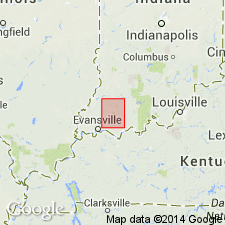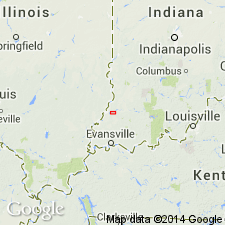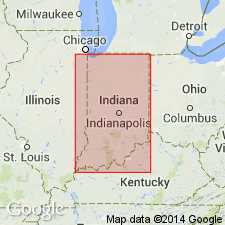
- Usage in publication:
-
- Ditney formation
- Modifications:
-
- Original reference
- Dominant lithology:
-
- Sandstone
- Shale
- Coal
- AAPG geologic province:
-
- Illinois basin
Summary:
Ditney formation. Sandstone and sandy shale with thin coal bed; 20 feet thick. Overlain by Inglefield sandstone and underlain by Somerville formation. Age is Pennsylvanian.
Caps Big Ditney and Little Ditney Hills, Warren Co., southwestern IN.
Source: US geologic names lexicon (USGS Bull. 896, p. 613).

- Usage in publication:
-
- Ditney formation
- Modifications:
-
- Not used
- AAPG geologic province:
-
- Illinois basin
Summary:
Ditney formation. This name has been dropped by Indiana Geol. Survey, the beds now being included in upper part of their newly defined unit called Shelburn formation. See E.R. Cumings, 1922 (Handbook Indiana Geol., pt. 4, Sep. Pub., no. 21, p. 525).
Source: US geologic names lexicon (USGS Bull. 896, p. 613).

- Usage in publication:
-
- Ditney formation
- Modifications:
-
- Reinstated
- AAPG geologic province:
-
- Illinois basin
Summary:
Pg. 126 (fig.1 ), 128-129. Ditney formation (restored) underlies Merom sandstone and overlies West Franklin limestone. Age is Late Pennsylvanian.
Source: US geologic names lexicon (USGS Bull. 1200, p. 1123).

- Usage in publication:
-
- Ditney Formation†
- Modifications:
-
- Abandoned
- AAPG geologic province:
-
- Illinois basin
Summary:
Pg. 48-49 (article by C.E. Wier). †Ditney Formation. Fuller and Ashley (1902, p. 2) applied name to rocks between Somerville Limestone (now West Franklin Limestone Member of Shelburn Formation) and Inglefield Sandstone Member of Patoka Formation. This section included 20 feet of shale, thin sandstone, and thin coal exposed in Ditney Hills, Warrick County (secs. 4, 5, and 6, T. 5 S., R. 9 W.). Wier (in prep.) assigned these rocks to Patoka Formation and retained name Ditney for the coal that was called Ditney Coal by Fuller and Ashley (1902, p. 2).
Wier (in prep.) [= Stratigraphy of the Carbondale and McLeansboro Groups in southwestern Indiana, Indiana Geol. Survey Bull. XX, 171 p., unpub. ms., ca. 1961; available online through Indiana Univ. Scholarworks http://hdl.handle.net/2022/3612, accessed on September 18, 2009].
Source: Publication.
For more information, please contact Nancy Stamm, Geologic Names Committee Secretary.
Asterisk (*) indicates published by U.S. Geological Survey authors.
"No current usage" (†) implies that a name has been abandoned or has fallen into disuse. Former usage and, if known, replacement name given in parentheses ( ).
Slash (/) indicates name conflicts with nomenclatural guidelines (CSN, 1933; ACSN, 1961, 1970; NACSN, 1983, 2005, 2021). May be explained within brackets ([ ]).

